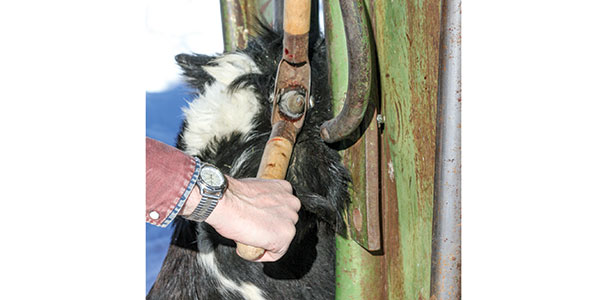However, the first few weeks after arrival are the most critical time for young calves. Stress factors such as weaning, transportation, nutritional changes, adverse weather conditions and other influences on the immune system can contribute to the onset of bovine respiratory disease (BRD), causing high morbidity leading to increased treatment cost, decreased weight gain, decreased performance and death.
The emphasis in the prevention of BRD is on the proper management of these calves before shipping to the feedlot. Calves should be properly vaccinated, weaned, castrated and dehorned at least four weeks before shipment so that any stress caused by these procedures has passed.
Stress down-regulates the immune response to viruses and bacteria which, in turn, makes calves more susceptible to infection, disease, and in the worst-case scenario, death. In this article we are going to focus on only one management procedure: the dehorning of cattle.

Horned cattle should be dehorned before or at the first processing, which usually leaves the calf with only a small defect in the head and a wound that will heal quickly.
Furthermore, it is less painful if the procedure is performed when the horn is small or only horn buds are present. The larger the horn, the more invasive the procedure, and therefore the more painful it is going to be.
In general, dehorning of cattle is a painful procedure and an animal welfare concern in the beef industry since polled animals could be used instead of horned.
When calves have only horn buds, the procedure is called disbudding. The horn buds can be cauterized, or a caustic cream can be applied.
This will prevent the growth of proper horns. Once the horns are bigger, as in older calves or even adult cattle, a Barnes dehorner, a keystone dehorner or obstetric wire might be used to remove them. In older cattle, this will often expose the horn sinuses and predispose the individual to infection.
Ranchers in the U.S. seem to have done an admirable job in reducing the percentage of cattle entering the feedlot with horns. According to the most recent National Animal Health Monitoring System (NAHMS) feedlot study, the percentage of cattle and calves arriving with horns in a feedlot has decreased from 17.4 percent to 11.7 percent as compared to the previous NAHMS report from 1999.
Interesting is the fact that, even though the numbers of cattle entering the feedyard with horns have decreased, the number of cattle getting dehorned in the feedlot has increased from 2.3 percent in 1999, to 12.7 percent in 2011.
This might be due to a greater awareness in feedlot management that horned cattle can lead to carcass bruising and therefore to decreased losses if the animals are dehorned.
A recent study from Kansas State University evaluated three different methods of dehorning and the associated wound healing of the dehorning site in feedlot cattle. The cattle in the study were divided into four different groups – those not dehorned at all (control), those dehorned with a keystone dehorner, those dehorned with a Callicrate bander and those on which the horns were just tipped.
Cattle dehorned mechanically with the keystone dehorner showed the highest vocalization score, indicating the greatest discomfort when compared to the other methods. However, the overall depression score (another indicator of compromised welfare) was higher in the group where the Callicrate band was applied to the base of the horn.
Furthermore, this study showed that the application of the Callicrate bander did not lead in all cases to a successful removal of the horns. In some cattle, the band fell off before the horn was eliminated, and only in three animals of the banded group did the horn actually fall off within four weeks of observation.
The results of this study show that banding of horns causes pain and discomfort, an extended procedure and marginal results. Banding of the horn is not recommended as a method for dehorning cattle.
Mechanical dehorning is a painful procedure for cattle. However, the use of pain medications and local anesthesia of the dehorning site can lead to the decrease or even alleviation of pain. This might be the future practice in feedlots to increase animal well-being and decrease additional stress factors when arriving at the feedlot.
Even acknowledging more humane methods of dehorning, pre-arrival processing procedures, such as vaccinations, dehorning, castrations and weaning should be performed in weeks before the animals enter the feedlot.
This will decrease financial losses due to disease and death as well as increase the market value of the cattle since polled or dehorned cattle will sell for more than horned ones. ![]()
PHOTOS
The best period for dehorning is when the horn is still in bud form. Photos by Paul Marchant.





